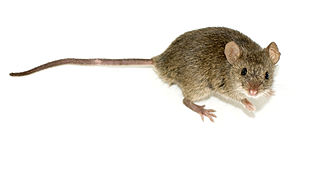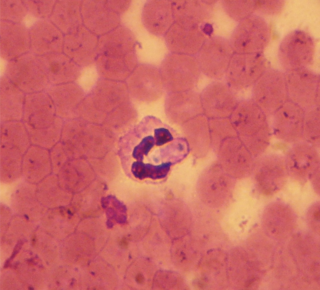
A mouse is a small rodent. Characteristically, mice are known to have a pointed snout, small rounded ears, a body-length scaly tail, and a high breeding rate. The best known mouse species is the common house mouse. Mice are also popular as pets. In some places, certain kinds of field mice are locally common. They are known to invade homes for food and shelter.

Rats are various medium-sized, long-tailed rodents. Species of rats are found throughout the order Rodentia, but stereotypical rats are found in the genus Rattus. Other rat genera include Neotoma, Bandicota and Dipodomys.

The house mouse is a small mammal of the order Rodentia, characteristically having a pointed snout, large rounded ears, and a long and almost hairless tail. It is one of the most abundant species of the genus Mus. Although a wild animal, the house mouse has benefited significantly from associating with human habitation to the point that truly wild populations are significantly less common than the semi-tame populations near human activity.

The laboratory mouse or lab mouse is a small mammal of the order Rodentia which is bred and used for scientific research or feeders for certain pets. Laboratory mice are usually of the species Mus musculus. They are the most commonly used mammalian research model and are used for research in genetics, physiology, psychology, medicine and other scientific disciplines. Mice belong to the Euarchontoglires clade, which includes humans. This close relationship, the associated high homology with humans, their ease of maintenance and handling, and their high reproduction rate, make mice particularly suitable models for human-oriented research. The laboratory mouse genome has been sequenced and many mouse genes have human homologues. Lab mice sold at pet stores for snake food can also be kept as pets.
The Virginia–Maryland College of Veterinary Medicine is a state-supported college of two states, Virginia and Maryland, filling the need for veterinary medicine education in both states. Students from both states are considered "in-state" students for admissions purposes.
Lymphocytic choriomeningitis (LCM) is a rodent-borne viral infectious disease that presents as aseptic meningitis, encephalitis or meningoencephalitis. Its causative agent is lymphocytic choriomeningitis mammarenavirus (LCMV), a member of the family Arenaviridae. The name was coined by Charles Armstrong in 1934.
"Behavioral sink" is a term invented by ethologist John B. Calhoun to describe a collapse in behavior which can result from overcrowding. The term and concept derive from a series of over-population experiments Calhoun conducted on Norway rats between 1958 and 1962. In the experiments, Calhoun and his researchers created a series of "rat utopias" – enclosed spaces in which rats were given unlimited access to food and water, enabling unfettered population growth. Calhoun coined the term "behavioral sink" in his February 1, 1962 report in an article titled "Population Density and Social Pathology" in Scientific American on the rat experiment. He would later perform similar experiments on mice, from 1968 to 1972.

Hepatozoon is a genus of Apicomplexa alveolates which incorporates over 300 species obligate intraerythrocytic parasites. Species have been described from all groups of tetrapod vertebrates, as well as a wide range of haematophagous arthropods, which serve as both the vectors and definitive hosts of the parasite. By far the most biodiverse and prevalent of all haemogregarines, the genus is distinguished by its unique reciprocal trophic lifecycle which lacks the salivary transmission between hosts commonly associated with other apicomplexans. While particularly prevalent in amphibians and reptiles, the genus is more well known in veterinary circles for causing a tick-borne disease called hepatozoonosis in some mammals.

Laboratory rats or lab rats are strains of the subspecies Rattus norvegicus domestica which are bred and kept for scientific research. While less commonly used for research than laboratory mice, rats have served as an important animal model for research in psychology and biomedical science.

Rodents are commonly used in animal testing, particularly mice and rats, but also guinea pigs, hamsters, gerbils and others. Mice are the most commonly used vertebrate species, due to their availability, size, low cost, ease of handling, and fast reproduction rate.

Aryl hydrocarbon receptor nuclear translocator-like 2, also known as Arntl2, Mop9, Bmal2, or Clif, is a gene.

Sodium/bile acid cotransporter also known as the Na+-taurocholate cotransporting polypeptide (NTCP) or liver bile acid transporter (LBAT) is a protein that in humans is encoded by the SLC10A1 (solute carrier family 10 member 1) gene.

Calcium-dependent secretion activator 2 is a protein that in humans is encoded by the CADPS2 gene.
Tyler Jacks is a David H. Koch Professor of Biology at the Massachusetts Institute of Technology (MIT), a long-time HHMI investigator, and Founding Director of the David H. Koch Institute for Integrative Cancer Research, which brings together biologists and engineers to improve detection, diagnosis, and treatment of cancer. Dr. Jacks is a member of the board of directors of Thermo Fisher Scientific and Amgen, two of the major biotechnology corporations in the world. He is the President of Break Through Cancer, a foundation dedicated to supporting multi-institutional teams of researchers focused on finding solutions to some of the most difficult to treat cancers. He is also a member of the Board of Overseers, the larger of two governing boards of Harvard University.

Infanticide is the termination of a neonate after it has been born, and in zoology this is often the termination or consumption of newborn animals by either a parent or an unrelated adult. In rodents, it is not uncommon for the mother to commit infanticide shortly after parturition under conditions of extreme stress, or for an unrelated male to kill neonates.

Jacqueline N. Crawley is an American behavioral neuroscientist and an expert on rodent behavioral analysis. Since July 2012, she is the Robert E. Chason Chair in Translational Research in the MIND Institute and professor of psychiatry and behavioral sciences at the University of California, Davis School of Medicine in Sacramento. Previously, from 1983–2012, she was chief of the Laboratory of Behavioral Neuroscience in the intramural program of the National Institute of Mental Health. Her translational research program focuses on testing hypotheses about the genetic causes of autism spectrum disorders and discovering treatments for the diagnostic symptoms of autism, using mouse models. She has published more than 275 peer-reviewed articles in scientific journals and 110 review articles and book chapters. According to Scopus, her works have been cited over 36,000 times, giving her an h-index of 99. She has co-edited 4 books and is the author of What's Wrong With my Mouse? Behavioral Phenotyping of Transgenic and Knockout Mice, which was very well received.

Murine polyomavirus is an unenveloped double-stranded DNA virus of the polyomavirus family. The first member of the family discovered, it was originally identified by accident in the 1950s. A component of mouse leukemia extract capable of causing tumors, particularly in the parotid gland, in newborn mice was reported by Ludwik Gross in 1953 and identified as a virus by Sarah Stewart and Bernice Eddy at the National Cancer Institute, after whom it was once called "SE polyoma". Stewart and Eddy would go on to study related polyomaviruses such as SV40 that infect primates, including humans. These discoveries were widely reported at the time and formed the early stages of understanding of oncoviruses.

Hantavirus pulmonary syndrome (HPS) is one of two potentially fatal syndromes of zoonotic origin caused by species of hantavirus. These include Black Creek Canal virus (BCCV), New York orthohantavirus (NYV), Monongahela virus (MGLV), Sin Nombre orthohantavirus (SNV), and certain other members of hantavirus genera that are native to the United States and Canada.
The development of an animal model of autism is one approach researchers use to study potential causes of autism. Given the complexity of autism and its etiology, researchers often focus only on single features of autism when using animal models.
Nobuyo N. Maeda is a Japanese geneticist and medical researcher, who works on complex human diseases including atherosclerosis, diabetes and high blood pressure, and is particularly known for creating the first mouse model for atherosclerosis. Maeda has worked in the United States since 1978; as of 2017, she is the Robert H. Wagner Distinguished Professor at the University of North Carolina at Chapel Hill.













